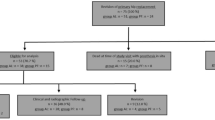Abstract
Background
A femoral implant with a modular sleeve and stem has been designed to allow independent and complete metaphyseal-diaphyseal fit and fill as well as independent rotation to accommodate anteversion at the time of THA.
Questions/purposes
In a prospective study we asked whether such a modular femoral sleeve and stem implant used during THA could provide (1) high long-term survivorship; (2) radiographically stable implants without radiolucencies, stress shielding, or osteolysis; and (3) high clinical scores in patients 15 to 20 years after a primary THA.
Patients and Methods
We prospectively evaluated 31 hips that underwent a primary THA using a modular femoral component for clinical outcome (Harris hip score) and radiographic outcome (implant stability, femoral loosening, osteolysis and stress shielding) at a minimum followup of 15 years (mean, 17 years; range, 15–20.2 years).
Results
There were no femoral revisions for aseptic loosening; all hips had radiographic evidence of bone ingrowth. Two well-ingrown components were revised for late hematogenous infection. Some degree of proximal femoral disuse atrophy from stress shielding occurred in 23 hips (74%) but was nonprogressive and did not result in any failures or complications. Femoral osteolysis occurred in 18 hips (58%), but we cannot definitively determine whether or not the modular junction contributed to this.
Conclusions
These data suggest this modular femoral stem can provide long-term survivorship with no cases of aseptic loosening at 15 to 20 years after primary THA. However, it may be prudent when using this femoral stem to consider an articulation with an alternative bearing or, if the modularity is not needed to address femoral anteversion and metaphyseal-diaphyseal mismatch, to consider a nonmodular femoral stem.
Level of Evidence
Level III, therapeutic study. See Guidelines for Authors for a complete description of levels of evidence.




Similar content being viewed by others
References
Adamany DC, Politi JR, Hauser WH. S-ROM hip prosthesis: 10- to 14-year results. Orthopedics. 2008;31:220.
Biant LC, Bruce WJ, Assini JB, Walker PM, Walsh WR. The anatomically difficult primary total hip replacement: medium- to long-term results using a cementless modular stem. J Bone Joint Surg Br. 2008;90:430–435.
Cameron HU. The 3–6-year results of a modular noncemented low-bending stiffness hip implant. J Arthroplasty. 1993;8:239–243.
Cameron HU. Modularity in primary total hip arthroplasty. J Arthroplasty. 1996;11:332–334; discussion 337–338.
Cameron HU, Keppler L, McTighe T. The role of modularity in primary total hip arthroplasty. J Arthroplasty. 2006;21(Suppl 1):89–92.
Charnley J. Long-term radiological results. In: Low Friction Arthroplasty of the Hip: Theory and Practice. New York, NY: Springer; 1979:84.
Christie MJ, DeBoer DK, Trick LW, Brothers JC, Jones RE, Vise GT, Gruen TA. Primary total hip arthroplasty with use of the modular S-ROM prosthesis: four to seven-year clinical and radiographic results. J Bone Joint Surg Am. 1999;81:1707–1716.
Efron B. Logistic regression, survival analysis, and the Kaplan-Meier curve. J Am Stat Assoc. 1998;83:414–425.
Engh CA, Massin P, Suthers KE. Roentgenographic assessment of the biologic fixation of porous-surfaced femoral components. Clin Orthop Relat Res. 1990;257:107–128.
Fabi DW, Goldstein WM, Gordon AC. Dislocation of an S-ROM total hip arthroplasty secondary to traumatic femoral stem dissociation from the metaphyseal sleeve. J Arthroplasty. 2009;24:159–164.
Fanuele J, Bernini P. Dissociation of the modular femoral stem from the metaphyseal sleeve during reduction of a total hip arthroplasty dislocation. J Arthroplasty. 2007;22:140–142.
Harris WH. Traumatic arthritis of the hip after dislocation and acetabular fractures: treatment by mold arthroplasty: an end-result study using a new method of result evaluation. J Bone Joint Surg Am. 1969;51:737–755.
Johnston RC, Fitzgerald RH Jr, Harris WH, Poss R, Muller ME, Sledge CB. Clinical and radiographic evaluation of total hip replacement: a standard system of terminology for reporting results. J Bone Joint Surg Am. 1990;72:161–168.
Kido K, Fujioka M, Takahashi K, Ueshima K, Goto T, Kubo T. Short-term results of the S-ROM: a femoral prosthesis operative strategies for Asian patients with osteoarthritis secondary to developmental hip dysplasia. J Arthroplasty. 2009;24:1193–1199.
Patel A, Bliss J, Calfee RP, Froehlich J, Limbird R. Modular femoral stem-sleeve junction failure after primary total hip arthroplasty. J Arthroplasty. 2009;24:1143–1147.
Rosenthall L, Bobyn JD, Tanzer M. Bone densitometry: influences of prosthetic design and hydroxyapatite coating on regional adaptive bone remodeling. Int Orthop. 1999;23:325–329.
Spitzer AI. The S-ROM cementless femoral stem: history and literature review. Orthopedics. 2005;28(9 Suppl):S1117–S1124.
Tanzer M, Chan S, Brooks CE, Bobyn JD. Primary cementless total hip arthroplasty using a modular femoral component: a minimum 6-year follow-up. J Arthroplasty. 2001;16(8 Suppl 1):64–70.
Acknowledgments
We thank Dr. C. Emerson Brooks for his continued support with this manuscript.
Author information
Authors and Affiliations
Corresponding author
Additional information
The institution of the authors has received funding from DePuy Orthopaedics, Inc, Warsaw, IN.
Each author certifies that his or her institution approved the human protocol for this investigation, that all investigations were conducted in conformity with ethical principles of research, and that informed consent for participation in the study was obtained.
About this article
Cite this article
Le, D., Smith, K., Tanzer, D. et al. Modular Femoral Sleeve and Stem Implant Provides Long-term Total Hip Survivorship. Clin Orthop Relat Res 469, 508–513 (2011). https://doi.org/10.1007/s11999-010-1524-0
Published:
Issue Date:
DOI: https://doi.org/10.1007/s11999-010-1524-0




